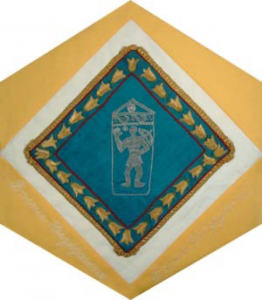Bosnia and Herzegovina

The Block
The block for Bosnia and Herzegovina was designed by Amira Geljo-Berberovic and Emir Geljo, and executed in embroidery by Mina Ganic. The central image features an embroidered depiction of a stecci (standing tombstone). There are an estimated 66,000 of these monolithic stone grave monuments throughout the country, the most famous collection of which is in Radimlja. Some of the earliest stecci date back to the 13th century and some weigh more than 30 tonnes. The figure of a man, his right hand upraised, is embroidered in silver against a blue silk background. His hand is a symbol of freedom and all the accompanying tenets of human rights. Gold lilies form an inner border with a complementary scallop of crochet around the outer edges. Lilies, which are present on the national coat of arms, have been a symbol of the country for centuries.
Cultural Profile
Bosnia and Herzegovina is a small country where ‘East meets West’ at the edge of Europe. The mountainous nation, which is slightly smaller than Nova Scotia, is located on the Balkan Peninsula and borders the Adriatic Sea and Croatia. Formerly part of Yugoslavia, Bosnia and Herzegovina declared its independence in 1992. The country consists of two regions: Bosnia––which takes its name from the Bosna River––in the north and Herzegovina––from the herzeg (duke) who once ruled the area––in the south. It is rich in natural resources, such as extensive forests and significant deposits of lignite, iron ore and copper. Its capital city, Sarajevo, captured the world’s attention as host of the 1984 Winter Olympics. The population of Bosnia and Herzegovina is comprised mainly of Bosniaks, Serbs and Croats and the official languages are Bosnian, Serbian and Croatian.
The territory of present-day Bosnia and Herzegovina has successively been part of the Kingdom of Bosnia, the Ottoman Empire, the Austro-Hungarian Empire and the Socialist Federal Republic of Yugoslavia, all of which have contributed elements to the unique culture of Bosnia. The arts in Bosnia and Herzegovina were highly developed, although following the country’s devastating civil war––which occurred after independence––much of the cultural legacy has been destroyed. As the country has regained some degree of normalcy, reconstruction of major cultural sites, such as the emblematic bridge of Mostar, has been undertaken.
Domestic arts continue to be very important in Bosnian and Herzegovinian households. Fundamental skills are passed down through generations of women and include crafts such as kilims (hand-woven carpets similar to Turkish rugs in design and colours), knotted rugs and silk embroidery. Embroidery, such as the Bosnia stitch, is widely done to adorn traditional clothing and household items. The traditional Zmijanje embroidery is also a centuries- old tradition specific to Bosnia.
Music and dance is divided into rural and urban traditions, the latter of which has been more strongly influenced by Turkish musical practices. The most widespread form of music in the country has been sevdalinka; emotional songs that speak metaphorically and symbolically of love won and lost. The country also has a rich tradition of folk dance, but like music, it is being affected by the rapid encroachment of modernity.
Until 1992, people coming to Canada from Bosnia and Herzegovina were listed under Yugoslavia. As a result of the country’s civil war, entire small communities relocated in Canada as refugees, some of whom went to British Columbia. They have established organizations, such as the B.C. Bosnian Association, that promote, maintain and share their culture with all Canadians. The 2011 census reports that there are currently over 22,000 Bosnians living in Canada.
Sponsor: Sponsors: Richard and Lorraine Lapointe
